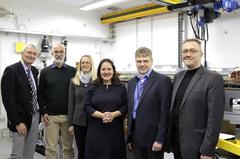URL: https://www.desy.de/news/news_search/index_eng.html
Breadcrumb Navigation
DESY News: Research Minister Schüle opens terahertz free-electron laser at PITZ accelerator
News
News from the DESY research centre
Research Minister Schüle opens terahertz free-electron laser at PITZ accelerator
Brandenburg's Minister of Research Manja Schüle today opened a new laser at the photoinjector test facility at DESY in Zeuthen (PITZ). The new laser, a terahertz free-electron laser (THz FEL), could pave the way for new research in a variety of scientific fields from the study of quantum materials to investigations into biomolecules, for instance at the European X-ray laser facility European XFEL. Minister Schüle was joined by Christian Stegmann, Head of DESY's Zeuthen site, Thomas Tschentscher, Scientific Director at the European XFEL and other partners of the project.

Minister Manja Schüle (center) in the tunnel of the PITZ II facility with Thomas Tschentscher, scientific director at European XFEL, DESY site director Zeuthen and director for astroparticle physics Christian Stegmann, accelerator physicist Anne Oppelt, PITZ group leader Frank Stephan and accelerator physicist Mikhail Krasilnikov (left to right). Credit: DESY, Susann Niedworok
The new terahertz laser generated its first light earlier this year. A terahertz laser delivers radiation of wavelengths from 0.1 to 1 mm, in this case wavelengths around 0.1 millimeters, which is about 100 times longer than the wavelength of visible light. This is in contrast with wavelengths produced by the European XFEL, which are much shorter than that of visible light. It can be used totransform or ‘pump’ matter into new states otherwise not accessible. These novel states of matter can then be probed using the European XFEL’s X-ray pulses.
"Many scientists and members of technical groups were involved in bringing this new idea to life at PITZ. This success opens up interesting new possibilities to advance science with terahertz radiation in a FEL configuration," explains Christian Stegmann.
The next step will be to show that it is possible to develop and install a similar terahertz free-electron laser at the at the European XFEL. This would enable new experiments that combine the long wavelength terahertz radiation with the European XFEL’s high energy short wavelength X-ray radiation.
"The lasing of the terahertz source at PITZ is an important milestone on the way to using terahertz radiation in a wide variety of scientific problems, and for us at European XFEL, it is an essential step in building a terahertz pump source," says Thomas Tschentscher.



